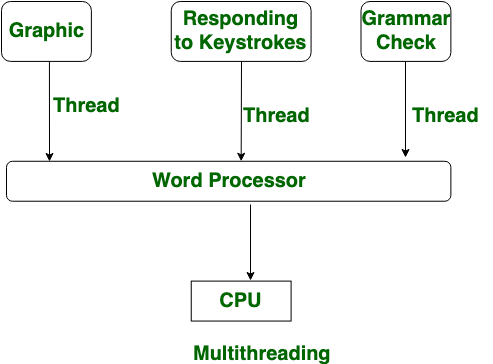先决条件——多道程序、多任务、多线程和多处理
多任务处理:
多任务是指提供一个 CPU 一次执行多个任务。多任务处理通常涉及任务之间的 CPU 切换,以便用户可以与每个程序一起协作。与多线程不同,在多任务中,进程共享单独的内存和资源。由于多任务涉及 CPU 在任务之间快速切换,因此从一个用户切换到下一个用户只需要很少的时间。

多线程:
多线程是一种系统,在该系统中,从一个进程中创建了许多线程,通过该进程可以增加计算机的能力。在多线程中,提供CPU是为了一次从一个进程中执行多个线程,而在多线程中,进程的创建是根据成本进行的。与多任务不同,多线程为进程提供相同的内存和资源以供执行。

让我们看看多任务和多线程之间的区别:
| S.NO | Multitasking | Multithreading |
|---|---|---|
| 1. | In multitasking, users are allowed to perform many tasks by CPU. | While in multithreading, many threads are created from a process through which computer power is increased. |
| 2. | Multitasking involves often CPU switching between the tasks. | While in multithreading also, CPU switching is often involved between the threads. |
| 3. | In multitasking, the processes share separate memory. | While in multithreading, processes are allocated same memory. |
| 4. | Multitasking component involves multiprocessing. | While multithreading component does not involve multiprocessing. |
| 5. | In multitasking, CPU is provided in order to execute many tasks at a time. | While in multithreading also, CPU is provided in order to execute many threads from a process at a time. |
| 6. | In multitasking, processes don’t share same resources, each process is allocated separate resources. | While in multithreading, each process share same resources. |
| 7. | Multitasking is slow compared to multithreading. | While multithreading is faster. |
| 8. | In multitasking, termination of process takes more time. | While in multithreading, termination of thread takes less time. |